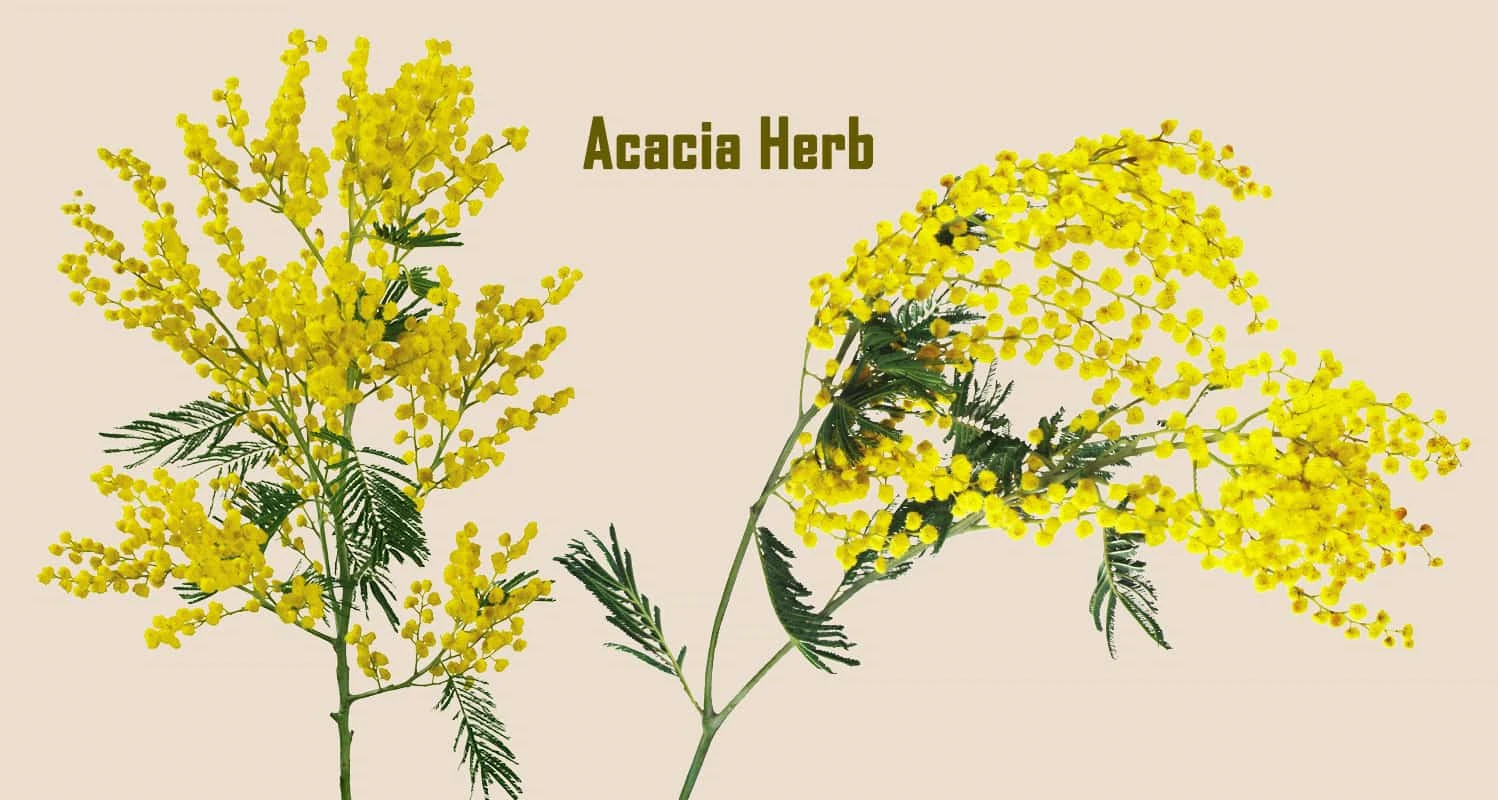reviewed by Truman Perkins
Although these past claims are not backed by evidence, acacia is still used for many things today. Acacia is packed with soluble fiber and beneficial prebiotics to make this a powerhouse herbal for overall good health.
Contents

From the Family Leguminosae. The two main types discussed in this article are. Acacia arabica and Acacia senegal. Other variations include Acacia catechu, Acacia decurrens, and Acacia farnesiana.
In different regions around the world, they may refer to an herb with various names. The most common terms that I have heard Acacia referred to as are: Gum Arabic, Wattles or Wattle, Babul, Indian Gum, Senegal, Cape Gum, Egyptian Thorn, Gum Acacia, Gum Senegal, and Tamarisk.
Growing to 30 to 70 feet, the Acacia tree often found in warm, arid climates. Often familiar are the yellow flowering branches that look like they have been blown upward and reach the sky.
They are native to the Nile, Ethiopia, East Africa, South Africa, and Arabia. Other species were born in Australia and other warm tropic and arid environments. The Australian and other species are traceable in lineage to their African ancestors.
The trees produce a pod-like fruit in addition to their beautiful flowers. Flowers are brightly colored and highly fragrant. Yellow is common, but cream and white are additional variations. Many times, the flower uses in the making of essential oils. Their pleasing scent and aroma-therapeutic properties make them an ideal herb for this purpose.
Over time and millennia, new subspecies have developed and flourished. Wikipedia list over 900 possible sub-species of this fantastic herb.
Several common species adapt to grow in other areas of the world. Perhaps you have an Acacia tree species near you?
These acacia species were born in the Hawaiian Islands. The wood of this Acacia also uses to make guitars and surfboards.
Photo By Forest & Kim Starr [CC BY 2.5 (https://creativecommons.org/licenses/by/2.5)], via Wikimedia Commons
This acacia tree/shrub is considered invasive in some areas, hence the foreboding name. The gum of this tree is often used to make jelly.
By Lazaregagnidze. [CC BY-SA 4.0 (https://creativecommons.org/licenses/by-sa/4.0)], from Wikimedia Commons
This thorny Acacia can be found along the coast and tolerate salty waters. Sometimes considered invasive, this is a hedge or shrub type. You can find it in Australia, Africa, and the California coast of the US.
By John Tann from Sydney, Australia (Kangaroo Thorn). [CC BY 2.0 (https://creativecommons.org/licenses/by/2.0)], via Wikimedia Commons
This type of Acacia has some of the prettiest flowers and has even received garden awards. Bright yellow balls adorn this 10 to a 25-foot tree with balls of color.
By Donald Hobern from Copenhagen, Denmark (Acacia bravissimo). [CC BY 2.0 (https://creativecommons.org/licenses/by/2.0)], via Wikimedia Commons
Some believe It used this type to build the Arch of the Tabernacle and Covenant in the Bible. This typical tall type has an inverted umbrella appearance and is native to Africa. The wood of this Acacia uses in constructing furniture and fences.
By Stolz Gary M, U.S. Fish and Wildlife Service [Public domain], via Wikimedia Commons
This was just a glance at the potential 900 subspecies of this fantastic herbal tree. They all have unique characteristics yet still similar growing habits.
Acacia is commonly used as a source of dietary fiber. This involves extracting the gum(sap) of the tree. This sap is dried and then ground into a fine powder that is dissolved in water.
Acacia also has many other medicinal properties that do not have to be derived from sap alone. In many cultures, the leaves, stems, and pods are used as well.
Flowers are used in part to construct essential oils for aromatherapy.
“Sap(gum), Leaves, stems, and pods.
Since Acacia load with beneficial soluble fiber, it naturally equipe to aid with digestion. It can have soothing effects for those who suffer from digestive disorders such as irritable bowel syndrome (IBS).
Acacia is a natural herb that acts as a demulcent, soothing to the mucous membranes. This soothing action can coat and soothe the irritations associated with sore throats. Many of today’s cough medicines and drops contain Acacia.
As a beneficial prebiotic, acacia helps cleanse the digestive tract and replace it with healthy gut bacteria. This is unlike many other products on the market for gut health due to this beneficial replacement factor. It is like out with the old and in with the good.
Unlike many fiber supplements, acacia ferments slowly in the stomach. This slow process decreases gas and bloat. This also eliminates unpleasant gas effects later as it enters the colon. Nobody wants embarrassing gas from trying to live a healthier lifestyle.
Acacia extract added to toothpaste can add an extra boost of gingivitis fighting power to your dental hygiene plan. It has also been found that this addition of acacia has a strong antibacterial effect on the mouth. This can help to prevent many gum diseases and reduce plaque.
Unique acacia honey, concentrated sweet sap, has strong antibacterial and antimicrobial properties. These fundamental properties are ideal for reducing and preventing acne breakouts.
A Nice full feeling! The fibers in acacia build up a gel in your tummy, causing you to feel fuller faster. This natural fiber prevents you from overeating and helps you feel full. Cravings subside, and snacking minimizes when you feel full at mealtime.
It keeps you feeling satisfied! The slower digesting of this soluble fiber also helps you to maintain that comfortable feeling longer. This slow digestion of acacia fiber can keep you feeling content until your next meal.
It slows sugar absorption! Due to it slowing digestion, it also helps to slow down the glucose absorption of your food. This can help to maintain energy longer and decrease the likelihood of insulin spikes and fat storage.
Optimize nutrient absorption! This slowed healthy digestion also improves the body’s ability to take up nutrients. You are benefiting more from the healthy foods you eat and not reaching for useless empty calories. A healthy body loaded with the proper nutrients has fewer cravings and better complete health-thereby aiding in weight loss.
See additional warnings and Side effects at WebMD.
⇒Disclaimer: The information presented here by Inside Herb Gardens and Its Authors is intended for educational purposes only. The FDA has not evaluated these statements and is not intended to diagnose, cure, treat or prevent disease. Individual results may vary. Before using any herbs, supplements, or other natural treatments, it is always advisable to consult your doctor or medical professional.
Egyptian ink was formulated with acacia as part of its ingredients. They used it to coat the bandages of the mummies and create inscriptions. Egyptian healers used acacia to heal many ailments, from sore throats and coughs to severe plagues.
It believes in Egypt that the first Gods were born from beneath the Acacia trees. This made the trees very sacred and held in high regard. Today, many cultures still use gum Arabic and resin of the acacia tree as a symbol of protection and a connection to divine (godlike) energy.
You can find acacia’s reach throughout other cultures and history dating back as far as 40CE from Greek botanist Dioscorides. Also, later placed in Roman history in Pliny’s herbal treatises as herbal medicine.
Today, acacia’s popularity has spread throughout many countries and cultures. It has been planted in more than 80 countries with more than 900 species and subspecies.
Articles on Site:
If you like Acacia, you may also be interested in these other great herbal powerhouse herbs on site.
Besides, learn about the folk medicine practice of creating Tinctures and extracts with the first article’s first article.
I know that I have run across several infomercials and web advertisements about diet products with acacia as an ingredient in recent years. It is nice to see that there is some acknowledgment of this beautiful herbal tree beginning to resurface.
I do often wonder, though, how much of these “new fancy” products are natural! Acacia as a standalone has many benefits. They can enrich many dietary and medicinal needs without fad plans and gimmicks.
I hope this article encourages you to explore this herb at its very heart and purest forms.
Have you tried acacia? Before this article, did you know about gum Arabic or any other common name for this herb?
Let me know your thoughts in the comments below. I look forward to sharing more acacia tree information with you!
 |
 |
 |
 |

About Truman Perkins
Truman Perkins is a Detroit-based SEO consultant who's been in the business for over a decade. He got his start helping friends and clients get their websites off the ground, and he continues to do so today. In his free time, Truman enjoys learning and writing about gardening - something he believes is a natural stress reliever. He lives with his wife, Jenny, and their twins in Detroit.
 |
 |
 |
 |
Get new FREE Gifts. Or latest free growing e-books from our latest works.
Disable Ad block to reveal all the links. Once done, hit a button below
 |
 |
 |
 |